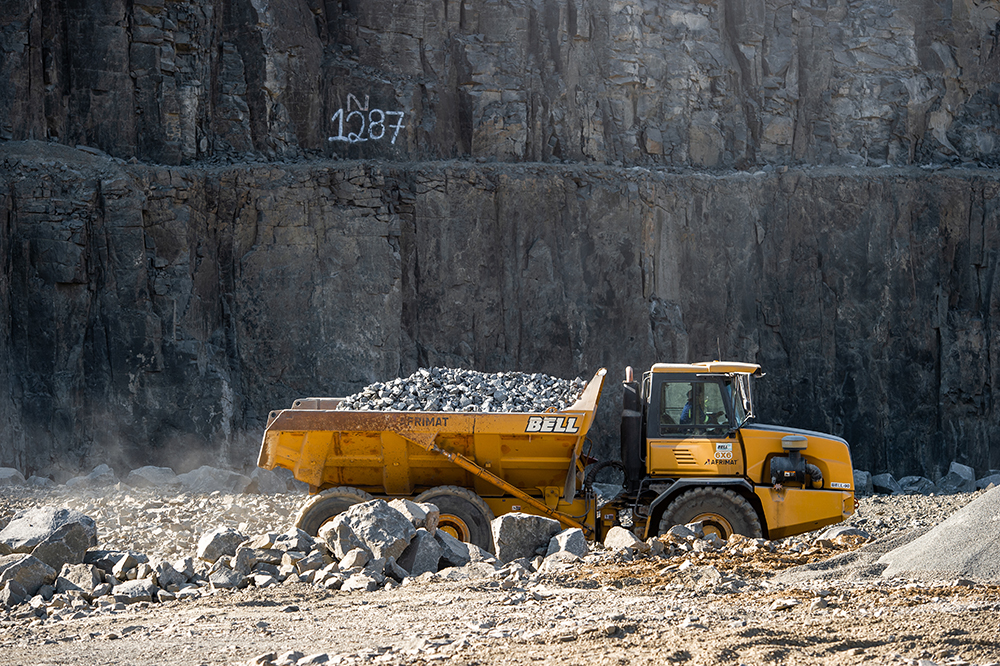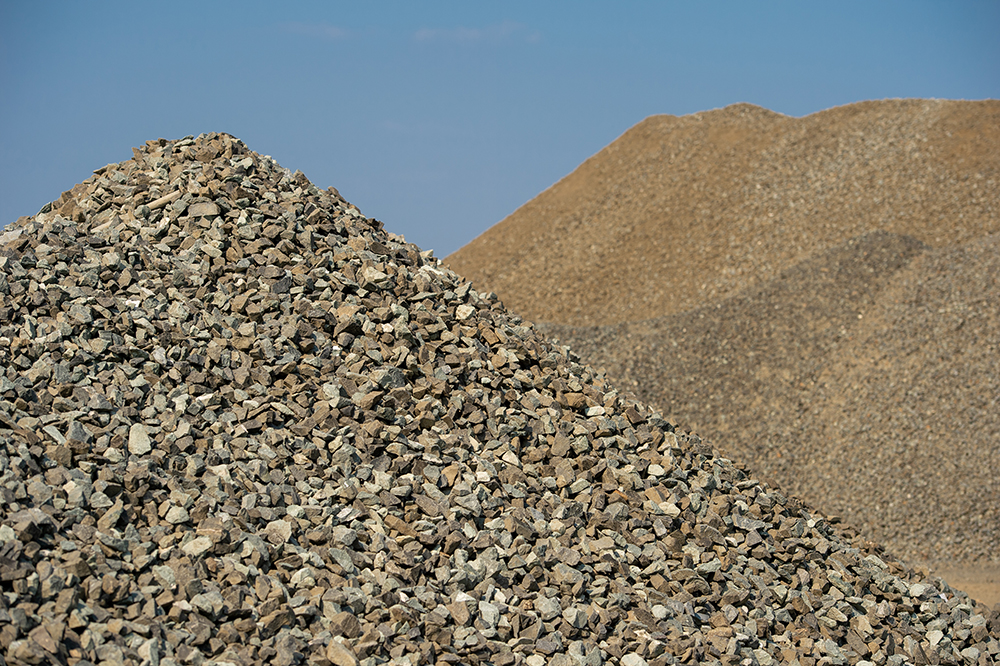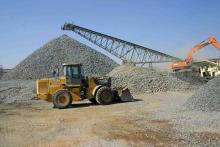
Like any other sector of the economy, the South African quarrying industry faced unprecedented challenges due to the coronavirus pandemic. A hard lockdown was enforced for the first time from 26 March to 30 April 2020, which saw a total shutdown of mines and quarries. Under Alert Level 4, from 1 – 31 May 2020, quarries could operate again, but the construction industry was still shut down. Construction materials sales only recommenced under Level 3 of the lockdown at the start of June, following the resumption of construction activity in the country.

Afrimat CEO Andries Van Heerden says the crisis came at a time when the industry was already suffering from reduced demand, thus aggravating an already complex business environment. Having reached its peak between 2016 and 2017, the construction materials market was already experiencing a “slightly negative trajectory” when COVID-19 hit at the start of 2020.
“The aggregates industry had already seen a significant decline from the 2016 volumes when COVID-19 hit at the start of last year, leaving many quarrying businesses vulnerable when the lockdown was announced unexpectedly,” says Van Heerden. “Quarries had in most cases absolutely no revenue for the month of April and a severely reduced revenue stream for May. Sales started slowly during June as construction contractors returned to work.”
Since then, Van Heerden has observed a marked increase in volumes across Afrimat’s national footprint. “We have seen a V-shaped recovery, with volumes even surpassing the pre-COVID levels at some point,” he says, adding that the company’s Construction Materials division’s return to profitability with a R1.6bn (rand) revenue contribution for the year ended 28 February 2021 is a key indicator of the industry’s revival.
Key to the recovery has been the government’s Recovery and Reconstruction Plan which, among others, has a special focus on implementing critical high-impact infrastructure projects to kick-start the ailing economy. At the centre of this plan is the infrastructure investment project pipeline worth R340bn in network industries such as energy, water, transport and telecommunications.
While the Recovery and Reconstruction Plan has been rather slow out of the starting blocks, Van Heerden has noted a meaningful rollout of road projects across the country, but significantly in three provinces – KwaZulu-Natal, Mpumalanga and the Western Cape. “As Afrimat, we have seen very good volumes in KwaZulu-Natal and Mpumalanga, especially around the Mbombela area. The Western Cape has also seen a strong pick-up in volumes, already coming from a high base,” he says.
There are several key projects currently underway in these provinces. A case in point is the multi-billion rand N2 Wild Coast Road (N2WCR) project, one of the massive infrastructure projects being developed as part of the Economic Reconstruction and Recovery Plan. It is strategically positioned on the N2, connecting four provinces (Western Cape, Eastern Cape, KwaZulu-Natal and Mpumalanga), and traverses Cape Town, George, Knysna, Gqeberha (formerly Port Elizabeth), East London, Mthatha, Durban and Ermelo. The project will also see the construction of two mega bridges – Msikaba and Mtentu. Once completed, Mtentu will be one of the highest bridges in Africa and among the longest in the world.

Van Heerden also makes special mention of the N3 upgrade, a major highway that links the economic hubs of Johannesburg and Durban. The R18.4bn project for the N3 upgrade in KwaZulu-Natal forms part of the national government’s key Strategic Integrated Projects. It focuses on an 80 km section from Durban to Pietermaritzburg.
Elsewhere in Mpumalanga, the R390m Karino Interchange in Mbombela is on course to be completed in November 2021. The interchange forms part of the government’s road infrastructure projects which are delivered through the South African National Roads Agency (SANRAL). This is complemented by three other road projects currently underway in the province, including the R380m eMalahleni – Middelburg road (pavement rehabilitation and upgrade); the R400m Belfast – Machadodorp road (rehabilitation and upgrade) and the 15.5km Kaapmuiden – Kaalrug road rehabilitation and upgrade project.
Van Heerden has also seen strong enquiries from the renewable energy sector, and believes that more of these projects will soon come to the market following President Cyril Ramaphosa’s recent announcement to increase the embedded generation threshold to 100 MW. To achieve greater energy security, a total of 1200MW of new generation capacity has now been connected to the grid from projects approved through Bid Window 4 of the Renewable Energy Independent Power Producers (IPP) Programme. A request for proposals has been issued for 2600MW of power from wind and solar PV projects through Bid Window 5.
Despite government efforts to drive infrastructure development, Van Heerden has noted a trend in the past decade where projects have become much smaller than they used to be. “This trend is much in line with what government is trying to achieve in terms of development of small-scale emerging contractors as the vehicle towards achieving economic growth, development and job creation for previously disadvantaged groups,” he says.
Additionally, he says, government spend on infrastructure is much lower than it was five years ago. “However, we see a little bit of civil infrastructure spend in the commodity space, where mines are busy with upgrades and expansions on the back of favourable commodity prices. As Afrimat, we are therefore supplying some significant volumes of aggregates in that area,” says Van Heerden.

The private commercial building sector is another area where Van Heerden has seen a significant drop in activity in the past year or so. A few years ago, there was a hive of building construction activity, especially in the Gauteng province, where the Sandton-Midrand-Centurion area had become a strategic hub for commercial building, along with complementary civil construction development. Some of the high-profile projects that have come to market in recent years include the Mall of Africa (said to be the biggest mall in Africa), the Alice Lane Bridge Phase 3, the Discovery Centre and the Standard Bank head-office expansion project, among several others.
“The building construction projects we had become accustomed to in recent years have suddenly dried up, and we are probably going to see more of that in the next few years as most of the real estate investment trusts are going to be under severe pressure with their balance sheets,” says Van Heerden.
To emerge stronger from the COVID-19 crisis, Van Heerden is of the view that quarrying companies, and businesses at large, should start focusing on reskilling their workforces now, especially given the loss of critical skills to rampant emigration. He also believes that as the Fourth Industrial Revolution (4IR) evolves, skills development becomes even more important given the changing skill sets.
“As a company, we took the decision to do something about this brain drain, instead of playing the victim. We started about 10 years ago with strong intellectual property, learnership and study assistance programmes. We have also implemented strong mentorship/coaching programmes to build a strong skills base,” he says.

“The resilient nature of our business in the past few years, as showcased by our strong financial performances, is in part a result of our strong focus on our people. We have demonstrated that it’s possible for companies to build their own skills,” adds Van Heerden.
Looking ahead, Van Heerden believes that technology will play a big role in the profitability of quarrying companies. He notes that the South African quarrying industry has traditionally lagged far behind the rest of the world in terms of technology uptake. “It’s high time we start looking at digital technologies, artificial intelligence and the Internet of Things to create enormous gains in productivity,” he says. “As a company, we are starting to take that seriously to drive world-class productivity at all our operations.”
Commenting on government efforts to kick-start the economy through infrastructure spend, Van Heerden says that while some progress has been made, acceleration of the remaining projects remains key to economic recovery. “We are comfortable with the current project pipeline and we are confident that the business will see some gradual growth in the short term. We are, however, hoping for government to accelerate much-needed infrastructure projects. As a business, we are extending an invitation to government to call on our expertise to help jointly execute infrastructure needed for the country,” he says.
Van Heerden also calls for government to be pragmatic about the regulatory regime to create an investor-friendly environment. “As a country we need to ensure that the investment environment is attractive to investors. I believe that this country has enormous potential if we overcome some of the challenges around the regulatory environment,” concludes Van Heerden.









